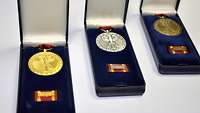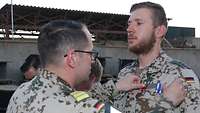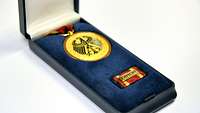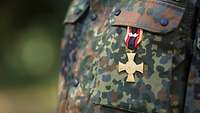The Bundeswehr Foreign Duty Medal
The Bundeswehr Foreign Duty Medal is a decoration for members of the armed forces. It is awarded for participation in operations abroad. Depending on the duration of the deployment, the Bundeswehr Foreign Duty Medal is awarded in bronze, silver or gold, or as the Combat Action Medal of the Bundeswehr.
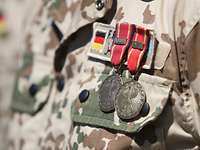
61 Operations abroad, 61 Bundeswehr Deployment Medals
Since 1996, there have been 61 different deployment medals for the Bundeswehr’s 61 operations abroad. These operations range from the mission in Afghanistan, the German Navy’s anti-piracy operation at the Horn of Africa, the armed forces’ disaster relief after the tsunami in Indonesia and rescuing shipwrecked people in the Mediterranean, to the special duties of individual military personnel for the United Nations, for example in Sudan. Since June 2014, the Bundeswehr Deployment Medal or outside of Germany’s national territory on ships or boats or in aircraft. The demands they place on personnel are equivalent to those of operations. The presence of German forces in the NATONorth Atlantic Treaty Organization battle group in Lithuania is one of these comparable deployments outside Germany.
The history of the Bundeswehr Deployment Medal
On 26 June 1996, Federal Minister of Defence Volker Rühe awarded the first Bundeswehr Deployment Medals to 26 military personnel who had, for example, served in Bosnia or participated in United Nations observation missions. The Bundeswehr Deployment Medal marked the German armed forces’ transition from an army for national defence to an army on operations abroad. The medal always looks the same: suspended on a black, red and gold ribbon, with a diameter of 3.5 centimetres. The German federal eagle appears on the front. The name of the operation is on the medal bar, a metal clasp attached to the ribbon.
Requirements for the medal
The requirements for the medal are always the same: personnel receive the bronze medal after at least 30 days on a deployment outside Germany, the silver medal after at least 360 days and the gold medal after at least 690 days. “It is simply a memento in the sense of a medal for participation. At an average of four euros, the material value is low, but it has great sentimental value for the recipients”, says Uwe Brammer, the deputy branch chief responsible for matters involving national decorations at the Federal Ministry of Defence. If someone is wounded or killed on operations, the medal can also be awarded before the required amount of time or posthumously. To date, the Bundeswehr Deployment Medal has been awarded 317,394 times in bronze, 13,730 times in silver and 1,398 times in gold (as of March 2019).
In the future, there will be a new effective date for awarding the Bundeswehr Deployment Medal: 1 November 1991 will replace 30 June 1995. This means that, for example, military personnel who participated in the UNUnited Nations[ mission in Cambodia in 1991 to 1992 or in the 1993 to 1994 blue-helmet mission in Somalia are also entitled to a Bundeswehr Deployment Medal.
How a Bundeswehr Deployment Medal is made
In July 2018, the Federal Minister of Defence introduced the 61st and most recent bar to date, bearing the designation “CDCounter Daesh/CB IRQCapacity Building Mission Irak” for participation in the Counter Daesh/Capacity Building Mission in Iraq. It is often a matter of just a few months from the initial idea to stamping a Bundeswehr Deployment Medal. In some cases, time is of the essence so that soldiers can receive the decoration while they are still in the country of deployment. “We follow the political developments, and, as soon as the German Bundestag has made a decision, the Ministry sees to it that a new Deployment Medal is introduced”, Brammer explains.
The Federal Office of Bundeswehr Personnel Management in Cologne receives the submission approved by the Federal Minister of Defence specifying the Deployment Medal in question and how many need to be produced. The employees develop a draft of the text for the award certificate and agree on it with the Federal Ministry of Defence. The budget department determines the costs for production of the medals. As soon as they get the green light, the Bundeswehr Deployment Medals are produced by a civilian company. The finished medals, ribbon bars and certificates are sent to the mission areas via the military postal service in Darmstadt. In the medal parade, an official ceremony generally held just before the end of the deployment, the relevant disciplinary superior at the level of battalion commander or higher awards the decoration to the soldiers
Awarding the Combat Action Medal of the Bundeswehr
As of the mid-2000s, combat with insurgents set deployments in Afghanistan apart from other operations. Military personnel could be wounded or killed in these engagements. On 9 November 2010, Federal Minister of Defence Karl-Theodor zu Guttenberg introduced the Combat Action Medal of the Bundeswehr in recognition of this great personal risk. He handed the first posthumous Combat Action Medal over to the family of Private Sergej Motz, who was killed in action in Afghanistan, on 25 November 2010. On 28 April 2009, the twenty-one-year-old and his patrol had been ambushed northwest of Kunduz. In the almost 30-minute engagement that followed, he was killed after fighting courageously. This engagement marked an unprecedented level of intensity for German soldiers deployed to Afghanistan. That is why 29 April 2009 is the date as of which the Combat Action Medal of the Bundeswehr may be awarded.
Requirements for the Combat Action Medal of the Bundeswehr
The Combat Action Medal of the Bundeswehr is awarded to personnel who have actively participated in combat at least once or suffered terrorist or military violence in which they faced great personal danger, for example due to booby traps or suicide bombers. To date, the Bundeswehr has awarded 5,845 Combat Action Medals.


